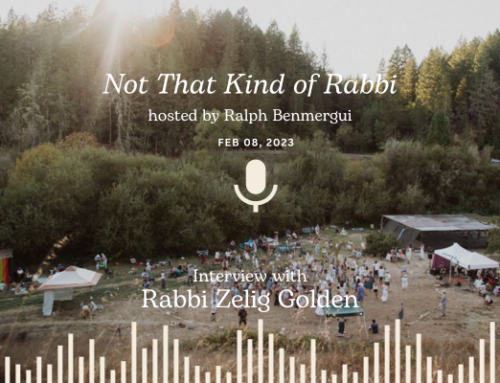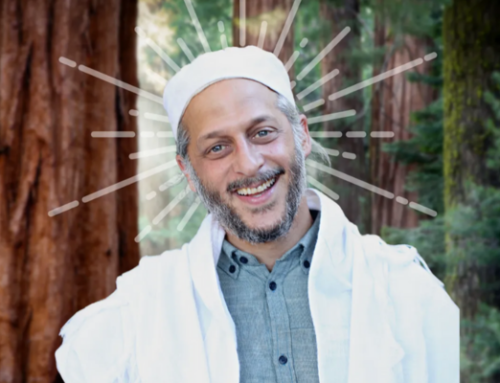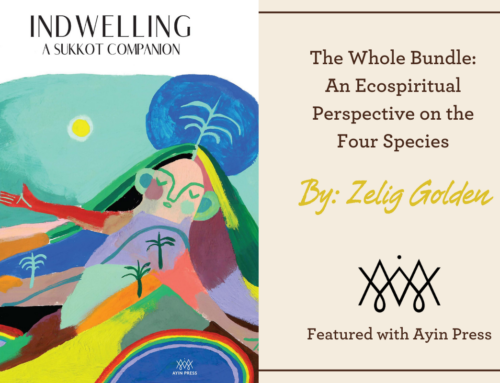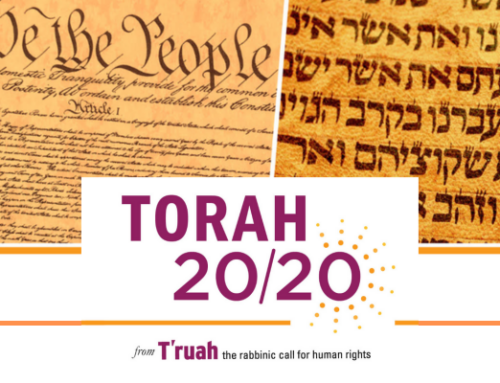The Jewish Medicine Wheel
17th of December, 2010 | Originally published in ZEEK
In my mid-twenties, I was drawn to live at a Jewish Retreat center in upstate NY where I created a home with other Jewish young people. Although I had come to dive into Jewish text and study, my clearest experiences of G-d happened in my time spent in the back woods with the trees and by the creeks. Instead of attending text study, or other Jewish programming I began spending more and more time in these magical woods. I found that I was wiser, more aware, and more at peace inside of myself when I made a regular connection with the natural world.
To explore this sense of connection, I began to study teachings from Native, earth-based cultures. Eventually, I apprenticed myself to Wild Earth, a program steeped in teachings of the Apache and other Native peoples. As I learned more about the way Indigenous cultures link human relationships to the cycles and wisdom of the earth, I came full circle, recognizing similar cultural patterns within the Jewish tradition.
These connections are built right into the Hebrew language. The Hebrew words for “human” clearly indicate that human-nature is elemental. Eish(a), wo(man), is from the same root as the Hebrew word for “fire.” Adam, human (or more literally earth-being), is from the same root as Adamah, “earth.” Humans are not separate from the earth. From dust we rise and to dust we return (Bereishit 3:19). Our corporal bodies are made of the same material as the rest of creation, so it makes sense that our yearly festival cycles and our personal life journeys are informed through observation of the cycles of the rest of nature. Yet, somehow, in Judaism, these earth-based patterns had become disconnected from their terrestrial source.
One way I began to see how to align our Jewish cycles with the earth was through the image of the Native medicine wheel. Used by a number of different Native peoples (including the Cherokee, Ojibwa, Lakotas and others), the medicine wheel points to the four cardinal directions and represents the circle of life. It is a symbol of the interconnectedness of all things.
Seeing our cosmology in a circle, with each seasonal cycle linked to our psycho-spiritual life journey, helps us to embody the earth’s cycles within ourselves. The medicine wheel is a road map that ultimately draws us back to our right placement in the circle of life. It reminds us that we ARE the earth. When we again truly realize our intimate connection with the rest of creation, we will be unable to recklessly harm life.
As I explored the medicine wheel, I found that other Jewish thinkers had also seen the connection. Rabbis Gershon Winkler (Magic Of The Ordinary) and Jill Hammer The Jewish Book of Days have each written about a Jewish medicine wheel, drawing on a number of sources including the Torah, Zohar, Sefer Yetzirah, our prophets, and other ancient texts.
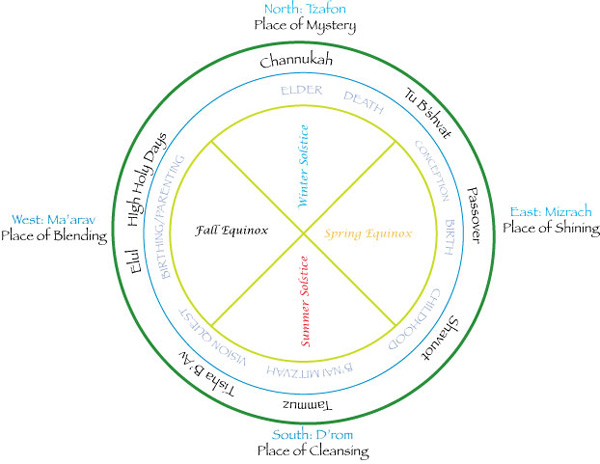
The Jewish holidays are reflections of our internal psychological landscape, following the cycles of the earth. Only in our modern world, where we are disconnected from nature, do we view time as linear. This leads to the scary notion that death is the “end.” In nature’s circular time death always brings new life. When we embrace this, we understand that endings in our lives beget new beginnings, just as the compost on the forest floor makes fertile soil for new growth. As an earth-based culture, Judaism embraces the natural deaths that are part of a human’s life through our yearly and life-time rituals.
The wheel I have outlined shows five layers that follow the natural cycles of:
- The cardinal directions
- One solar day
- One solar year
- One Jewish year
- The stages of one human life
The East, Mizrach, the “place of shining,” is where the sun rises, is the Spring Equinox, Nissan, Passover, and represents new beginnings and birth. The 1st of Nissan is Rosh HaChadashim, the “beginning” of time. On Pesach we leave Mitzrayim (literally, Narrow place) and are birthed as a nation through the waters. In our lives, we pass through the narrow birth canal in the waters of birth. This is our first rite-of-passage where we are welcomed into the world with a naming ceremony or Brit Milah, songs, blessings, and loving arms. Reb Sarah says that in Judaism the east is the place of new beginnings and also of the past. “All new beginnings draw their sustenance from what has come before. Our past propels us to where we are going.”
The South, D’rom, “the place of heights,” also known as Neghev, the “place of cleansing” is noon, the heat of the day, fire, summertime, Tisha B’Av and Tu B’Av. It is the time of day when we are most productive and the time of the year when the plants are in their most abundant growth. The flowers are in full radiance and these are the teen years where one discovers the unique flower of their personal expression to the world. Interestingly, in the height of the summer is Tisha B’Av, a mourning period for the destruction of the temple, and in more ancient times, was linked to summer solstice when we mourn the dwindling of the light of the summer sun as it begins to move towards the shorter days of Autumn.
This is reflected in two important life passages that involve mourning the loss of our childhood as we move towards the ripe harvest of our adulthood in the West. One is the Bar/Bat Mitzvah, which we are familiar with, and the other we have lost connection to in modern Judaism–the Vision Quest and Initiation into adulthood.
The time between the South and West is a time when we are cut loose from the family who raised us and are expected to find our own way. Many people spend their 20s searching for their soul’s vision, sometimes without knowing that is what they are doing. A community that understands this helps the initiate by recognizing the death of their old, childhood self, and supports their re-birth into the next phase of life.
The Bar/Bat Mitzvah initiation and the Vision Quest were both originally earth-based rituals, embraced by the tribe, that involved physical as well as spiritual challenges in the wilderness. Just as our ancestors had to spend 40 years in the wilderness to pass into the promised land, each one of us must leave everyday life, and in the dynamic solitude of nature find our truest voice. This space is sorely missing in our culture, and re-claiming this ancient rite would create a world of people who joyously know and share their personal gifts.
The West, Ma’arav, “the place of blending” is where the sun sets and corresponds with Autumn and the High Holy Days when the final harvests of the year are coming in. In the course of a day, it is the ingathering time, when we gather for a meal with our family. In our life, it is the time when we harvest all that we have learned and we begin to confidently share our gifts with our community. This is the place of birthing, where we give birth to children and/or our unique offering to the world. I asked Rabbi Sarah Etz-Alon why the west, which seems to be the most stable part of person’s life is associated with blending, the state of being neither here nor there. She responded that an adult is someone who no longer sees the world as black or white, good or bad, but can live within ma’arav, the blending, ever-changing, and ultimately undefinable in-between space that is life.
The North, Tzafon, “the hidden place”. This is midnight, winter, Chanukah and the place of mystery. This is the place of the Elder, the one who serves in the twilight of their life. To be a true elder, one must have passed through each direction and be able to guide and initiate others because of what they gained in their journey around the wheel. We meditate into the flickering flame of the chanukia and we are reminded of Eish, the word for fire and human that reflects our mysterious and spiritual nature. In the midst of the winter, the natural world is dormant, and in the human cycle, one prepares for death, coming ever closer to the non-physical world. When death arrives we enter into the liminal space in-between, the place of twilight. We prepare for the sunrise of our next gilgul—the Hebrew word for reincarnation, or literally “wheel.”
What I have explained is only the first layer of a cosmology that draws deep from Kabbalah and our mystical teachings, of which I am only a beginning student. Some food for thought that takes this even more out of linear time: Reb Sarah explains that just as the angels of Jacob’s dream were ascending and descending on the ladder at the same time, the Jewish medicine wheel moves in both directions. All directions are happening simultaneously even though one may be more illuminated in our present moment.
Like a vibrant eco-system, where the fallen leaves create fertile soil for new growth, the spiritual compost of each phase of our life cycle creates fertile ground for our next personal evolution. We have seen the destruction and violence that results from a world that sees Adam (earth-being) as separate from Adamah (earth). I believe that, as a culture, we are in the pre-dawn (the Northeast) and are moving towards the east where, from the Mitzrayim (narrow place) of our current socio-cultural landscape, we will birth a new culture that embraces ourselves as an intimate part of all creation.

